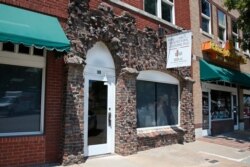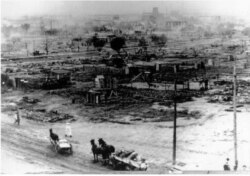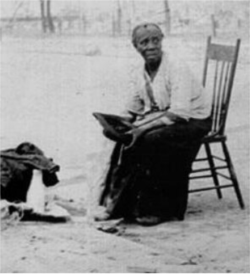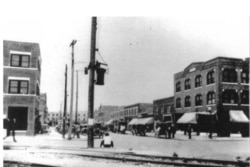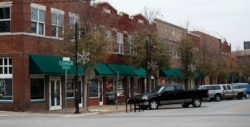Until recently, many Americans had never heard of the Greenwood District of the city of Tulsa, Oklahoma, one of the largest, most prosperous Black communities in the United States that was destroyed in 1921 during what the Oklahoma Historical Society calls the “single worst incident of racial violence in American history.”
Before 1921, most of Tulsa’s 10,000 African American residents lived in the vibrant district with flourishing Black-owned businesses, two newspapers, several churches, a hotel and library. Some referred to Greenwood as the Black Wall Street.
“The notion of Black communities actually being self-sufficient or Black people actually running things is not as prominent in the American historical frame, even today,” says Gregory Fairchild, whose father and grandfather grew up in Greenwood.
“As a Black community, the idea is that, well, we must be talking about something that is in fact, moribund, high crime, not having the trappings of so-called American life. But my grandfather grew up in and watched the destruction of such a community and also watched such a community come back and raised his son there,” he adds.
Riots ignited in June 1921 after a Black teen was falsely accused of assaulting a White woman. An armed White mob flooded the African American district, looting and setting homes and businesses on fire. When it was over, 35 square blocks of homes and businesses had been destroyed. A 2001 commission found that 168 people died in the violence, but other reports put the number as high as 300.
Most of Greenwood’s residents were left homeless by the riot and spent that winter living in tents. But Greenwood did rebuild. Fairchild, a professor and associate dean of business administration at the University of Virginia, says his father grew up there after the riots.
“The community was destroyed, but actually it came back...so my dad growing up in that community had two college educated parents, and he himself became college educated, again solidly middle class,” Fairchild says. “I think that the reason the story has taken on such interest is both scale and scope, the size of the massacre, but also the idea that it happened to a community that was intact but also economically vibrant.”
Greenwood declined in the 1960s and 1970s, as urban renewal projects transformed the inner city. An interstate cut off the business district from the rest of the neighborhood. Financial institutions left, decreasing opportunities for local residents to build wealth through savings or loans.
In addition, the civil rights movement gave Black people the option to shop at stores once reserved for whites, which meant they spent less money in their community.
“The loss of this economic capital has impacted all aspects of the African American experience from education to political influence to the ability to even preserve and tell our history,” says Brent Leggs, executive director of the African American Cultural Heritage Action Fund.
Although Black Wall Street is gone, Leggs believes Greenwood can serve as a model for the future.
“I think being able to understand that African American communities were once thriving centers with cultural institutions and banks and theaters, and houses of worship, and schools, and houses and beyond that, sets a blueprint for being able to reestablish this sense of community and the opportunity to create healthy and vibrant neighborhoods,” he says.
Fairchild has spent a lot of time assessing how to financially reinvigorate Black communities.
Although segregation is illegal, most Americans remain racially segregated, living in neighborhoods and going to school with people who look like them. Fairchild says this leads to depressed social and economic incomes for Black Americans because that financial inequity begins practically at birth.
One way to help close the gap is by establishing financial institutions like banks and credit unions in lower income communities, managed by Black people or members of other marginalized groups.
“Having the presence of financial institutions in the places where people live and work becomes important because those financial institutions are mechanisms to provide capital for the local entrepreneur,” Fairchild says. “They’re mechanisms to allow people living in those communities to have access to savings or loan products.”
But perhaps most important of all, says Fairchild, is that Americans recognize that society remains mostly segregated and take steps to end that.
"I call it the illusion of inclusion,” he says. “I tend to believe that the firms will begin to reflect the environment in which people live and work and since we live in segregated communities and we attend segregated schools, I would expect the firms that we will run will remain segregated unless we are intentional in our recruitment, development, and promotion.”
Main photo (top) courtesy of the Greenwood Cultural Center





